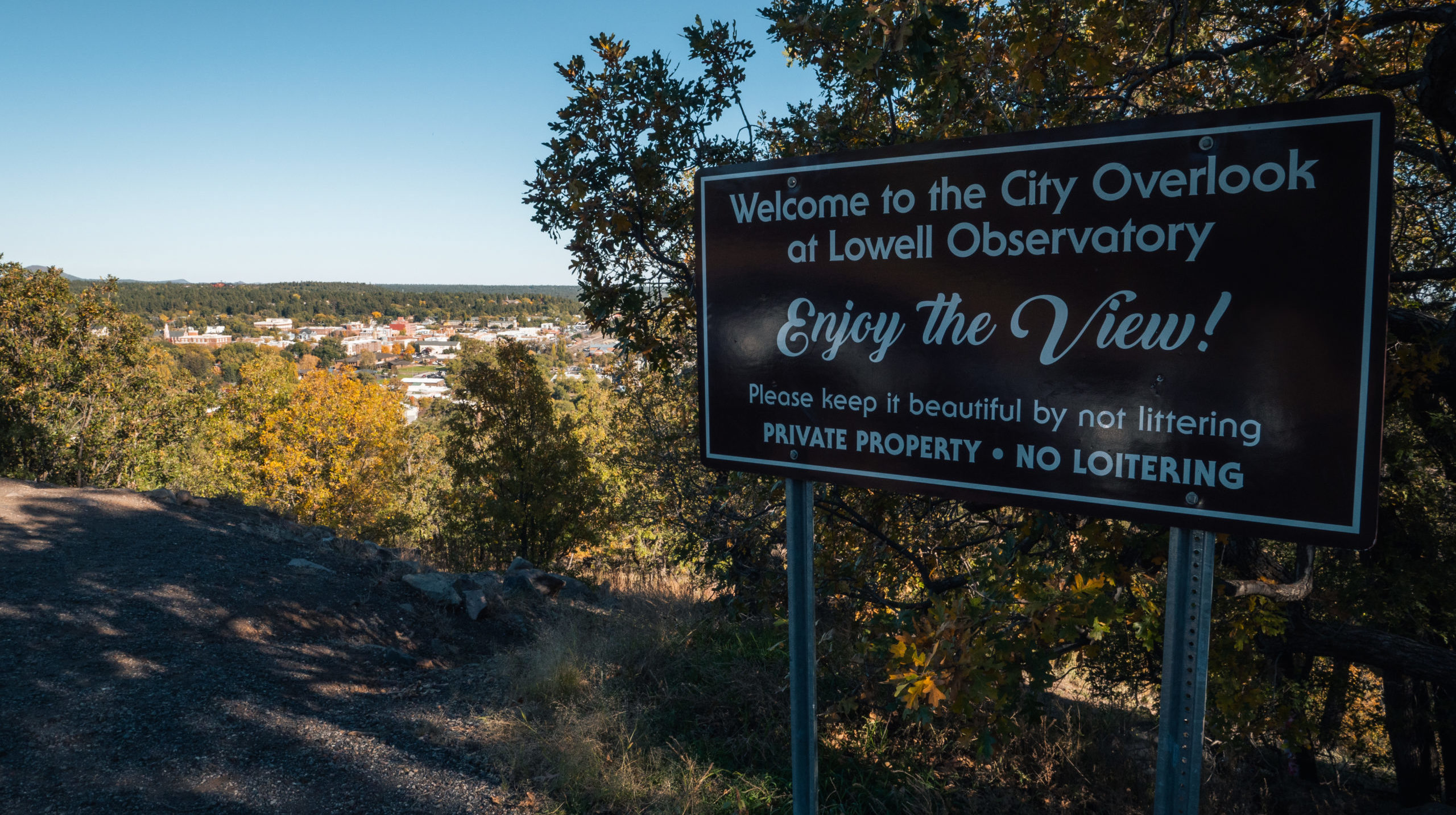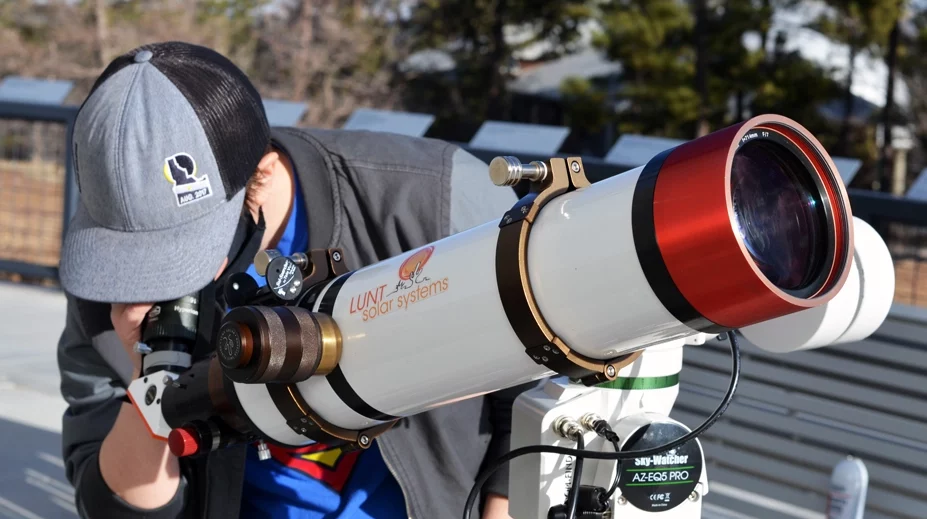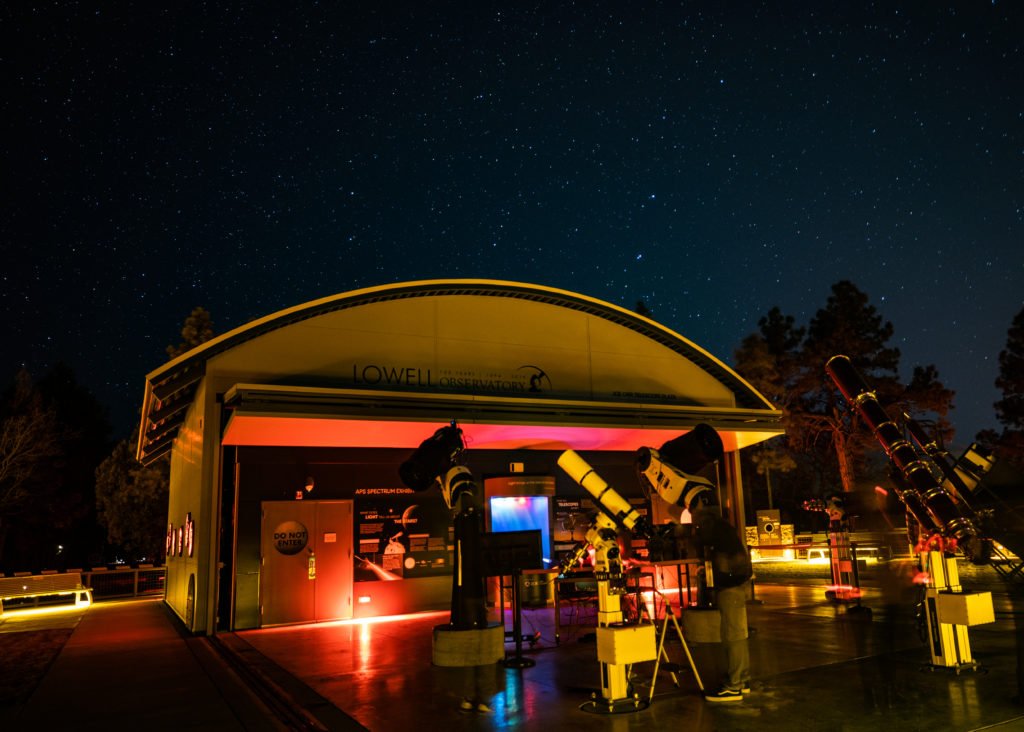
Quaking aspens show off their fall colors on Lowell's scenic campus. Credit: Nate Nise
Itinerary For a Perfect Fall Day at Lowell Observatory
So, you’d like to visit the observatory, but you’re not sure of the best way to budget your time? Never fear: check out this sample itinerary of a perfect fall day spent at Lowell, from morning to evening, to help you plan!
🍁 11:50am | Enjoy the View from the Mars Hill Lookout
11:50am | Enjoy the View from the Mars Hill Lookout
After driving up the winding road that leads to the observatory, you and your group pull off onto the scenic overlook located just outside of the observatory’s entrance. You step out of the car and the air is crisp and cool, the Sun is shining, and there’s not a cloud in the sky. You enjoy a sweeping view of downtown Flagstaff and snap some group photos — the changing leaves make an excellent seasonal addition to the background!
🍁 12:00pm | Check in at the Steele Visitor Center
You get back in the car and drive through a pair of pillars on either side of the road, one of which reads “Lowell Observatory.” The other features the planetary symbols of each planet in our solar system — including little Pluto, of course! You pull into the parking lot, park, and then head to the Steele Visitor Center on foot. You take a moment to admire a statue of planet Mars in front of the building, which also functions as a giant kaleidoscope.
Once inside the visitor center, you’re greeted by the friendly face of a Visitor Experience Associate (VEA) at the front desk. They help you purchase general admission tickets for the whole group, and everyone gets a map and a visitor sticker to wear on their shirt. Printed on the back of the map is a schedule of the day’s programming, including talks, tours, open houses, and evening stargazing.
The VEA tells you that the Solar Viewing program has just begun, and recommends heading over to the Giovale Open Deck Observatory (GODO) to see the Sun through a solar telescope. They point out its location on the map for you and give you directions.
As you head out the back door of the visitor center, you take note of the gift shop and make plans to check it out later on.
🍁 12:30pm | Solar Viewing & Open House at the GODO
The path to the GODO begins near a small cluster of trees. You and your group walk at a leisurely pace along the path. When you arrive at the GODO, its garage-like front door is rolled open to reveal the telescopes inside. You’re greeted by an Educator in a red polo shirt, who directs you to the Solar Telescope, a small, portable device.

As you look through the eyepiece, the Educator tells you that the telescope’s ultra-filtered lens works like a high-powered pair of sunglasses to allow for direct observation of the Sun’s surface. You can’t believe your eyes — the big red circle you’re seeing is actually the Sun! You look closer and see that it has some darker spots sprinkled around its surface (Sun spots, the educator explains) and swirling tendrils coming off of its edges (solar flares!).
After each member of your group has a chance to look at the Sun, you wander inside of the GODO’s main structure. The telescopes aren’t ready to view the stars just yet, but it’s amazing to get an up-close look at them in the light of day. A nearby Educator explains that when it’s time for viewing, the entire structure rolls back on a rail system to expose the telescopes to the night sky. They also tell you that telescope viewing begins around sunset every night as long as the weather cooperates, but tonight’s forecast shows for perfectly clear skies.
You check the programming schedule and see that the 45-minute Lowell Tour is starting in the Giclas Lecture Hall at 11:00am, so you spend some more time milling around the GODO plaza and checking out exhibits before you head back down to the visitor center.
🍁 1:15pm | Lowell Tour
You return to the Steele Visitor Center and enter the Giclas Lecture Hall, where you join some other groups of guests in the rows of seats. Another educator is there to greet your group, and you chat as more guests filter in.
When the tour begins, the Educator gives you a presentation that includes a brief overview of Lowell’s rich history. This includes the story of the observatory’s founder, the brilliant and eccentric Percival Lowell. You learn that Percival (referred to affectionately by some observatory staff members as “Uncle Percy”) was among the first astronomers to muse about the possibility of alien life on Mars.
After the presentation comes the walking portion of the tour, which takes you on a short walk to the Clark Telescope Dome. Once inside, you spend some time admiring the dome’s intricate wooden interior and taking in the sight of the towering 24″ Clark Refractor itself. The Educator guiding your tour tells you about the history of the telescope and its dome.
🍁 2:30pm | Story of Pluto Tour
After the Lowell Tour concludes, you head to the Rotunda Museum. There, you’re met by another educator who teaches you about the groundbreaking discovery that put Lowell Observatory on the map. You also learn about Clyde Tombaugh, the tenacious 23-year-old Kansanite who discovered Pluto in 1930, as well as the arduous process that led to his historic discovery.
Then, the educator takes you up the Universe Walk to the Pluto Discovery Dome, the very facility where Tombaugh made his groundbreaking discovery.
🍁 4:00pm | Putnam Collection Center Open House
After lunch, you head to the Putnam Collection Center for an open house. There, you browse a selection of fascinating exhibits, including Vesto Slipher’s spectrograph and Percival Lowell’s 1911 Stevens-Duryea automobile “Big Red.”
There are also rotating exhibits like Lowell’s Lunar Legacy and the Lampland Diaries. You can also catch a glimpse of the archive conservatory, which houses thousands of precious artifacts from our history through a floor-to-ceiling window.
🍁 4:30pm | Rotunda Museum Open House
You make your way back to the center of campus to check out the exhibits in the Rotunda Museum. Suspended from the ceiling of its dome is the Saturn Lamp, a stained-glass light fixture crafted by the Los Angeles Light Company in 1918.
Other noteworthy items on display in this venerable building are Percival Lowell’s first telescope, the blink comparator Clyde Tombaugh used to discover Pluto (recently returned from the Smithsonian!), and an interactive OmniGlobe.
🍁 5:00pm | Colors of the Cosmos Talk
You head back to the Giclas Lecture Hall for Colors of the Cosmos, and interactive science presentation that asks the question, “What can blue fire tell us about the nature of the universe?”
You watch as Lowell educators reveal secrets of the cosmos by playing with light, rainbows, and fire in a series of family friendly experiments.
🍁 5:30pm | Leaf Watching & Lowell Mausoleum
Once Colors of the Cosmos concludes, you take some time to admire the vibrant fall leaves on the trees around campus.
Your walk takes you to Percival Lowell’s final resting place, a beautiful granite mausoleum built to resemble a telescope dome. It’s located just across from the dome that houses his beloved Clark Telescope, which he used in his search for the fabled ‘Planet X.’
🍁 6:00pm | The Universe in Motion Talk
You head back to the Giclas Lecture Hall to hear another talk — this one is about the motion of the universe!
Learn about the movement of stars and galaxies and what that movement can teach us. Dive into Lowell’s history with V.M. Slipher and the expansion of the universe, as well as modern occultation research. This talk includes small demos.
🍁 6:30pm | Leave Campus for Dinner
The Sun has begun to set, and soon the telescopes will be open for evening stargazing! Since general admission tickets give you the ability to come and go as you like, you and your group decide to leave campus to grab some dinner. Careful to hold on to your visitor sticker, you get back in the car and head to downtown Flagstaff to find somewhere to eat (pssst — you can find a list of local restaurants here).
🍁 7:45pm | Return to Lowell for Evening Stargazing

The Sun has set and the stars have begun to appear in Flagstaff’s pristine dark skies — which means it’s time for some stargazing! Before heading back to campus through the visitor center, you put on gloves, hats, and warm jackets to stay comfortable as the temperature drops (you heard that nighttime temps can drop below 30 degrees!). The VEA at the front desk tells you that the six state-of-the-art telescopes at the GODO are now open for viewing. When you head to the path that leads to the observation deck, you realize that the path you saw earlier in the day glows in the dark! When you arrive at the GODO, you and your group have an opportunity to view different objects through each of the GODO’s telescopes, including one that projects images onto a screen.
Once you’ve had your fill of incredible views at the GODO, you head to the historic Clark Telescope Dome to view celestial objects as they were seen by Percival Lowell himself in the late 1800’s. You and your group are thankful that you packed warm clothes — the telescope domes aren’t heated, as heat waves would create interference in the telescopes’ lenses.
🍁9:00 | Shop for Souvenirs in the Starry Skies Shop
Satisfied with your day at Lowell, you return to the Steele Visitor Center to browse the Starry Skies Shop’s selection of products. It seems to have something for everyone, and each member of your group is able to find the perfect item to commemorate their amazing day at the observatory. After checking out in the giftshop, you take in the view of downtown Flagstaff’s glimmering city lights (which are in compliance with local dark sky ordinances, of course!) as you drive back down Mars Hill.